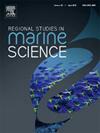Population structure and allometric patterns in mangrove horseshoe crab, Carcinoscorpius rotundicauda from the coastal area of Cox’s Bazar, Bangladesh
IF 2.1
4区 环境科学与生态学
Q3 ECOLOGY
引用次数: 0
Abstract
A study on population structure, morphological variation and allometric pattern of the mangrove horseshoe crab (Carcinoscorpius rotundicauda) was carried out in four sites (Dorianagar, Khurushkul, Moheshkhali and Rejukhal) in Cox’s Bazar, Bangladesh. Two methods (walk-through and gill netting) were used to collect horseshoe crabs. A total of 202 individuals were sampled, with a male-dominated sex ratio of 1.69:1. The results indicated significant differences in body weight (BW), prosomal width (PW), carapace length (CL), total length (TL), and telson length (TEL) among the sites and between sexes. Females exhibited larger morphometric measurements than males across all locations except Rejukhal, having the highest mean body weight in males (228.2 ± 29.2 g) and females (227.3 ± 44.5 g) of Dorianagar. Males of Rejukhal showed a lower mean body weight (165.42 ± 14.92 g) compared to females (154.20 ± 9.91 g), indicating some variability in trends. Size distribution analysis revealed that most individuals fell within the 13.0–14.9 cm PW range, in case of Khurushkul showing the highest density. Correlation analysis demonstrated significant positive relationships among key morphological traits, particularly between BW, PW, CL, and TL. The Principal Component Analysis (PCA) identified BW, PW, and TL as the most influential traits distinguishing between sexes, with PC1 explaining 73.8 % and 69.1 % of the variation in males and females, respectively. The Discriminant Function Analysis (DFA) further confirmed BW as a key trait for sex differentiation, achieving a 78.7 % accuracy rate in classification. Allometric growth analysis revealed negative allometry (b < 3) in the TL-BW, PW-BW, and CL-BW relationships in males and females across sites, with notable exceptions in males of Khurushkul (PW-BW) and females of Dorianagar (CL-BW) displayed isometric growth (b = 3). However, TL-TEL relationship across all sites showed positive allometry (b > 1) except that of Rejukhal where both males and females showed isometric growth (b = 1). These findings are anticipated to help determine the size variations among the individuals of C. rotundicauda in different sites of Cox’s Bazar and serve as a foundation for future research to compare different populations.
孟加拉国考克斯巴扎尔沿海地区红树马蹄蟹的种群结构和异速生长模式
对孟加拉国考克斯巴扎尔地区4个地点(Dorianagar、Khurushkul、Moheshkhali和Rejukhal)红树林马蹄蟹(Carcinoscorpius rotundicauda)种群结构、形态变异和异速生长模式进行了研究。采集马蹄蟹的方法有两种:穿越法和刺网法。共取样202人,男性占主导地位的性别比例为1.69:1。结果表明,在不同位点和性别之间,体重(BW)、泌体宽度(PW)、甲壳长度(CL)、总长度(TL)和端子长度(TEL)均存在显著差异。除Rejukhal外,雌性的形态测量值均大于雄性,雄性的平均体重最高(228.2 ± 29.2 g),雌性最高(227.3 ± 44.5 g)。Rejukhal雄性的平均体重(165.42 ± 14.92 g)低于雌性(154.20 ± 9.91 g),表明趋势存在一定的变异性。大小分布分析表明,大多数个体分布在13.0 ~ 14.9 cm PW范围内,以Khurushkul密度最高。相关分析表明,主要形态性状之间存在显著的正相关关系,尤其是体重、体重、体重和TL之间。主成分分析(PCA)发现体重、体重和TL是区分性别的最具影响力的性状,PC1分别解释了雄性和雌性差异的73.8% %和69.1% %。判别函数分析(Discriminant Function Analysis, DFA)进一步证实体重是性别分化的关键特征,分类准确率达到78.7% %。异速生长分析显示负异速生长(b <;3)在TL-BW、PW-BW和CL-BW的雌雄关系中,除雄库鲁什库尔(PW-BW)和雌多里安那加(CL-BW)外,其余3个位点的TL-TEL关系均呈正异速生长(b >;1)除了Rejukhal外,雄性和雌性均呈等长生长(b = 1)。这些发现有望帮助确定Cox 's Bazar不同地点圆尾圆尾圆蚧个体的大小差异,并为未来不同种群的比较研究奠定基础。
本文章由计算机程序翻译,如有差异,请以英文原文为准。
求助全文
约1分钟内获得全文
求助全文
来源期刊

Regional Studies in Marine Science
Agricultural and Biological Sciences-Ecology, Evolution, Behavior and Systematics
CiteScore
3.90
自引率
4.80%
发文量
336
审稿时长
69 days
期刊介绍:
REGIONAL STUDIES IN MARINE SCIENCE will publish scientifically sound papers on regional aspects of maritime and marine resources in estuaries, coastal zones, continental shelf, the seas and oceans.
 求助内容:
求助内容: 应助结果提醒方式:
应助结果提醒方式:


